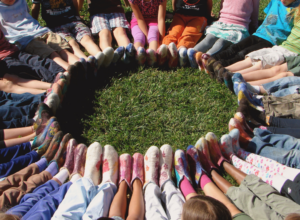Why it’s important to bring joy back into education.
New research from the Harvard Graduate School of Education highlights the critical importance of joy in education.
If schools replace joyful modes of learning with high stress methods, neuroscience researchers find that students learn less and have more difficulty with mental processing and long term memorization.
That is why in Waldorf Education we incorporate stories, theater, outdoor learning, art, movement, play, music, project-based learning, and community service throughout our curriculum.
This holistic and joy-filled approach to education helps our students engage with subjects from multiple angles, deepen their understanding, and develop a lifelong love of learning.
When students go through a time of particular stress, such as a pandemic, the need to bring joy into education is more important than ever.
Educators talk about the impact COVID has had on school happiness.
“If there has ever been a time where I’ve witnessed the widespread erosion of joyfulness among children and school-aged youth, it has been throughout the past two years.
In March 2020, joy gave way to confusion, fear, and uncertainty as the world came to terms with the severity of the COVID-19 pandemic.” –Decoteau Irby, associate professor at the University of Illinois at Chicago
The Harvard Ed Magazine article, “A Space for Joy”, by Lory Hough states:
“Julia de la Torre, Ed.M.’06, is tired… She says, ‘I’m wearied by carrying the emotional weight of people’s worst fears about their health.’ But more than anything, she says she’s worried that during these chaotic years, her relationship with students, staff, and families has been rooted in crisis.”
That’s where the need for joy comes in.
The foundation for learning must involve joy in school and in each lesson. That way, students will gain the confidence they need when they do struggle.
“When we scrub joy and comfort from the classroom, we distance our students from effective information processing and long-term memory storage,” Judy Willis recently wrote in the Neuroscience of Joyful Education.
Willis continues, “when students are engaged and motivated and feel minimal stress, information flows freely through the affective filter in the amygdala and they achieve higher levels of cognition, make connections, and experience ‘aha’ moments. Such learning comes not from quiet classrooms and directed lectures, but from classrooms with an atmosphere of exuberant discovery.”
So, how do we ensure that students find joy during hard times?
At Summerfield, we have found several ways that we can bring joy to our school.
1. Our biodynamic farm and nature filled campus brings joy to the students, staff, and faculty alike.
2. We ensure that our classrooms provide students with an atmosphere of discovery, through project-based learning, outdoor learning, stories, and more.
3. We offer an expansive curriculum that incorporates academics, art, movement, handwork, music, and play throughout every grade.
4. We have used the pandemic as an opportunity to consider how we meet the needs of all our students. And to ensure that they have the tools and support they need to thrive in their academic and social lives.
5. We host summer camps for our students and extended community to participate in. A Farm Camp, Circus Camp, and Chinese Language & Culture Camp.
6. We have implemented smaller scale events and celebrations for our school community. Our traditional festivals like Sprites Night, Winter Faire, and May Faire looked different during the past few years, but it has been important to maintain a sense of familiarity and celebration nonetheless.
- Sprites Night
- Winter Faire
- May Faire
Learn more about Summerfield or apply now!





